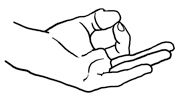
- Vinyasa Yoga School
- 2 minute read
1. Jnana Mudra

Jnana Mudra (the wisdom seal) is done by touching the tips of the thumb and the index together, forming a circle, with the hands placed on the knees in seated meditation with the palms facing up. Notice, can you feel the sense of insight with your palms facing upward? This mudra is supposed to give a feeling of spaciousness and have a subtle uplifting effect on the body and mind.
2. Chin Mudra
Chin Mudra (the consciousness seal) is done in a similar fashion as Jnana Mudra with the tips of the thumb and the index together, forming a circle, however hands are placed on the knees in seated meditation with palms facing down. Notice, can you feel the sense of grounding with your palms facing downward? This mudra stimulates the root chakra through the downward energy connecting us with the earth.
3. Dhyana Mudra
Dhynana Mudra (the meditation seal) is done by placing the back of the right hand on the palm of the left hand with both hands resting in the lap. Notice, can you feel a sense of balance with your hands held together in this way? Through connecting the hands, this mudra coordinates the right and left hemispheres of the brain and unites all opposites.
